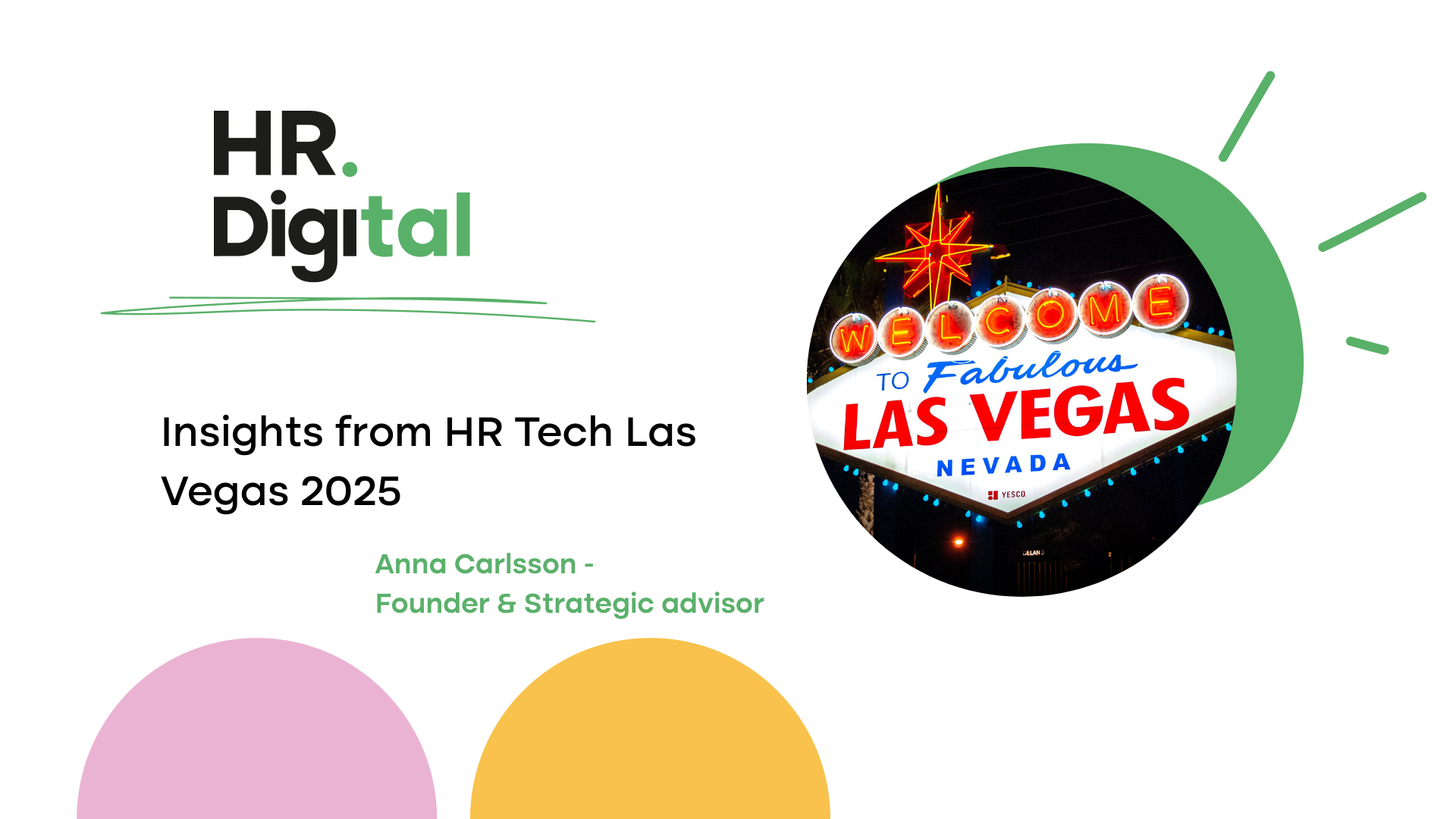The past few weeks have been amazing. First, horseback riding in Arizona 🐎, followed by four intense days in Vegas at the world’s largest HR Tech event. After that, I had the opportunity to speak, share, discuss, and guide HR leaders – and even a CEO – on the topic of HR 2026.
Naturally, I’m sharing some key insights from my experience at HR Tech here. I’ve also recorded a podcast episode with Emira on the same topic, which will be released on October 13 (Swedish but transcribed in english). In it, I go deeper than I can in this shorter newsletter.
On October 13, the final episode of HR Digitaliseringspodden – in its current form – will be released. For the past six years, I’ve approached the podcast with great ambition and a strong focus on delivering a high-quality product. But for various reasons, the podcast won’t sound or be released in the same way going forward.
There will likely be a short break. Or you might hear an episode where I simply speak straight into the mic – no intro music, probably no guests, just straight to the point. I’m inspired by how Josh Bersin does this in his own episodes. That means the format will be different, but the turnaround from recording to release can be faster. And I’ll be able to cut production costs and save project management time.
If you believe the podcast should continue in its current form – with top-tier content and inspiring guests – I’m looking for a sponsor who wants to take over the operational side. I’d love to stay on as the voice, but I’d need someone else to handle the planning and execution. Let me know if you’re interested!
Market analysis, vendor recommendations, and concrete advice for strategic decisions.
I now have more information than ever before – and clearer advice to share. That’s why I’ve decided to put together a report, which will be available from mid-November. In it, I’ll gather everything from what you need to consider in your organization, future outlooks, and available vendors, to data, statistics, report references, and other supporting material. Resources you may need in your strategic planning and decision-making processes.
I’m curious about the report: Future-Proof HR – Insights and Strategic Choices for 2026
This edition includes:
✨ Insights from HR Tech Las Vegas 2025
👌 Anna’s activities
💡 Noted in the HR Tech industry
📅 Events & learning calendar on the website: HRdigi | Event and education calendar 2025
Just back from this year’s HR Tech Conference in Las Vegas, I’m feeling both inspired and overwhelmed – even with my daily work in this field.
Everything is changing at the same time.
AI, the way we organize work, user behaviors – all shifting simultaneously, along with broader forces like geopolitics, economics, and demographics.
Yes, new tools and tech were the talk of the town. But underneath it all was a much bigger question:
How does this reshape the very core of our work and our organizations?
One thing was clear: AI is no longer just a function – it’s reshaping the entire experience and execution of work. Instead of menus, portals, and clicks, we’re starting to talk to systems. The interface has become a conversation.
Josh Bersin calls this a “discontinuous break” – a paradigm shift where the old user interfaces, training platforms, and self-service models are being replaced by AI-driven dialogues.
For HR, this opens up massive opportunities. We can create accessible, personalized experiences for candidates and employees.
But it also brings new responsibilities.
If AI becomes the primary touchpoint – what then is the role of HR?
Our responsibility shifts toward ensuring quality, ethics, data integrity – and shaping the experience behind the experience.
Many HR systems showcased their AI capabilities, but actual usage remains low. Sapient Insights Group reported that while 90% of systems in their survey have AI or analytics functionality, only 40% are actively using it – and 29% of users don’t even know what AI features their systems offer.
Meanwhile, shadow AI is exploding:
81% of employees are using external AI tools not approved or governed by their organizations.
Why?
Because the company tools don’t meet their actual needs.
At the same time, AI investments have reached new heights – close to a trillion dollars globally in 2025 alone. And it shows. Solutions for recruitment, analytics, learning, and automation dominated the conference.
Niche, agent-based solutions like SonicJobs, Fountain, and ai.work are on the rise – challenging the speed and flexibility of traditional platforms.
But amid the tech hype, one fundamental insight stands out:
AI is not the solution – it’s a tool.
And it’s a very different kind of tool than those we’ve used before. Its impact only materializes when tied to real needs, concrete problems, and an honest understanding of the current state.
One key trend in this year’s Sapient Insights data: Change management is gaining significant ground.
AI projects are not tech projects – they are transformation projects.
This requires strong leadership, psychological safety, and an HR function capable of explaining, translating, and leading.
It’s also clear that the HR role itself is structurally changing.
Josh Bersin described a shift from 1 HR person per 100 employees to 1 per 150–200.
Automation is freeing up time – but demands new skills: data literacy, change management, and influence.
Terms like superworkers and agentic AI were everywhere.
But what do they actually mean?
Every role must be re-evaluated:
Which tasks can be automated?
Which require emotional intelligence, ethics, or human presence?
Solutions like Techwolf and Reejig help organizations break down roles into tasks, skills, and responsibilities – revealing what can be done by humans vs. AI.
And all of this stirs up concern.
Employees worry about falling behind.
Managers worry about losing control and relevance.
Executives face board pressure to cut staff and boost productivity – without always knowing how.
Here, HR plays a critical role – not just as system owners, but as transformation leaders and culture shapers.
So, what do I take home from Vegas?
That it’s no longer enough to simply keep up.
We need to redefine how we work, lead, and organize.
The technology is here.
The real question is:
What do we want to use it for?
Want me to come and talk about future challenges, choices, and strategies with your team? You can reach me at anna.carlsson@hrdigi.se.
The biggest news since the last newsletter is, of course, Workday’s acquisition of Swedish company Sana, now valued as one of Sweden’s unicorns – joining the ranks of Klarna, Spotify, and Lovable.
My breakfast colleagues at HR Tech in Vegas literally screamed when they heard the news. And so did I!
With this acquisition, Workday takes a major leap in its AI strategy – confirming the need for smart acquisitions when operating on an older tech platform that requires much more work to integrate AI into the existing environment.
With its recent acquisitions (Sana, Paradox, HiredScore), Workday gains access to top expertise and some of the most modern solutions I’ve tracked as global leaders – even before the deals were made.
Sana combines both a learning platform and agent technology that I personally use. Just like with the Paradox acquisition, Sana is expected to continue as both a standalone and integrated offering.
At the same time, Workday launched its new developer platform – Workday Extend Build – enabling customers to create their own AI solutions directly within the Workday environment. This strengthens Workday’s ability to support customer-driven innovation and build agent-based workflows with a low threshold.
👉 https://newsroom.workday.com/2025-09-16-Workday-Signs-Definitive-Agreement-to-Acquire-Sana
The Swedish Internet Foundation has released its annual report on our use of the internet and AI.
👉 https://svenskarnaochinternet.se/rapporter/svenskarna-och-internet-2025/
Fosway has released its annual report on Cloud HR – a broad spectrum of HR system solutions delivered via the cloud – with a particular focus on Core HR and platforms managing large parts of HR processes in organizations.
This year, the message is clear: technology is no longer the bottleneck. Instead, Fosway points to the need for HR to take the lead in work design: reshaping roles, tasks, and organizational structures in step with the rise of AI.
👉 https://www.fosway.com/9-grid-2/cloud-hr/
On September 4, OpenAI announced that it is building a new Jobs Platform – but it’s not just another job board. With launch planned for mid-2026, OpenAI aims to create a matching engine between real business needs and actual skills.
By combining insights into company challenges (via AI integrations) with individual behaviors (via ChatGPT), OpenAI could become the first to measure competence based on what people do and learn – not just what they say they know.
Proponents envision a system where CVs are replaced by demonstrated skills, matching happens in real-time, and learning becomes visible through how we use AI. Critics warn of privacy risks, EU legal limits, and overconfidence in AI’s ability to interpret behavior as genuine competence.
This will be fascinating to follow 👏🏻
Fontainebleau Las Vegas managed to hire 6,500 people in just four months – thanks to an AI-driven strategy focused on the candidate experience. By leveraging agent-based AI, the team was able to automate and streamline large parts of the recruitment process, making it possible to handle huge volumes without sacrificing quality.
A concrete and interesting example of how agent AI not only boosts efficiency but also improves the candidate experience.
👉 https://hrexecutive.com/6500-hires-in-4-months-behind-fontainebleaus-ai-hiring-strategy/
Tandem Health has quickly become one of the hottest Swedish AI companies. Dubbed “doctors’ best AI companion,” the company closed a funding round this summer of SEK 475 million.
Their solution records and summarizes conversations between doctors and patients, freeing up administrative time that can instead be spent on patient care.
For years, changing employers has been the obvious career move for anyone looking to boost their salary. But new data, commissioned by Dagens Nyheter, shows that this old truth is shifting. For the first time in a long while, loyal employees are seeing the same salary increases as job-hoppers.
According to Gritify and Akavia, the shift is partly due to the economic downturn. Companies with healthy finances often reward those who stay – to retain valuable talent. International data reflects the same trend.
👉 https://www.dn.se/ekonomi/att-vara-hoppjerka-pa-jobbet-lonar-sig-inte-langre/
The purpose of this newsletter is to share news from the HR Tech market and highlight trends in digitalization, AI, and innovation for leaders and HR professionals.
About me
My name is Anna Carlsson, and I’m a strategic advisor and HR Tech analyst. I help HR and leadership teams make smart decisions in HR Tech, AI, and digitalization – through strategies that are clear, sustainable over time, and actionable. Assignments range from one-hour advisory calls to long-term projects where I support you all the way from current state to concrete results.
I run HR Digi, supporting HR professionals and HR Tech companies in navigating, understanding, and leading in a digital era. And it doesn’t always take major change – sometimes it’s about clarifying, prioritizing, and communicating strategically to achieve success.
Also proud memebr of Top 100 HR Tech Influencers globalt 2024 & 2025 🙏

